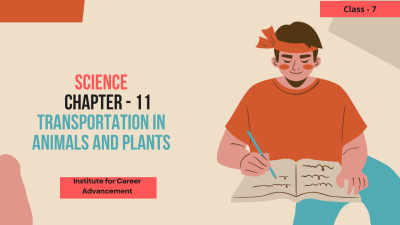Transportation in Animals and Plants - Class 7
"Transportation in Animals and Plants" is a fundamental concept taught in Class 7 biology, focusing on how organisms move essential substances like water, nutrients, gases, and wastes within their bodies. In animals, this involves the circulatory system ; blood vessels, heart ; for transporting oxygen, nutrients, and waste products. In plants, transportation occurs through the vascular system : xylem and phloem, where xylem transports water and minerals from roots to leaves, and phloem transports sugars produced in leaves to other parts of the plant. Understanding these processes helps students grasp the mechanisms that sustain life in both animals and plants. "প্রাণী এবং উদ্ভিদে পরিবহন" হল ক্লাস 7 জীববিজ্ঞানে শেখানো একটি মৌলিক ধারণা, যেটি কীভাবে জীবগুলি তাদের শরীরের মধ্যে জল, পুষ্টি, গ্যাস এবং বর্জ্যের মতো প্রয়োজনীয় পদার্থগুলিকে স্থানান্তরিত করে তার উপর দৃষ্টি নিবদ্ধ করে৷ প্রাণীদের মধ্যে, এটি অক্সিজেন, পুষ্টি এবং বর্জ্য পণ্য পরিবহনের জন্য সংবহন ব্যবস্থা (রক্তবাহী জাহাজ, হৃদয়) জড়িত। উদ্ভিদে, ভাস্কুলার সিস্টেমের (জাইলেম এবং ফ্লোয়েম) মাধ্যমে পরিবহণ ঘটে, যেখানে জাইলেম শিকড় থেকে পাতায় জল এবং খনিজ পদার্থ পরিবহন করে এবং ফ্লোয়েম পাতায় উৎপন্ন শর্করা উদ্ভিদের অন্যান্য অংশে পরিবহন করে। এই প্রক্রিয়াগুলি বোঝা শিক্ষার্থীদের প্রাণী এবং উদ্ভিদ উভয়ের জীবনকে টিকিয়ে রাখার প্রক্রিয়াগুলি উপলব্ধি করতে সহায়তা করে।
English
Last updated
Wed, 27-Nov-2024



















